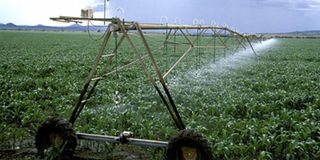Invest in irrigation to ensure food security

What you need to know:
- However, it is understood that Tanzania has 44 million arable hectares, with only 33 per cent of them being cultivated
- It is therefore pertinent to exhaust all possibilities including ensuring crops are grown on all its 29 million hectares suitable for irrigation, as only five million hectares are cultivated.
As climate change is taking its toll globally, challenges abound including those on environment and food security. With Tanzania’s population growing at 3.1 per cent annually and expected to reach 134 million by 2050, up from 50 million this year, one may be tempted to jump to conclusions of employing Malthusian mechanisms ruthlessly to avert food woes.
However, it is understood that Tanzania has 44 million arable hectares, with only 33 per cent of them being cultivated
It is therefore pertinent to exhaust all possibilities including ensuring crops are grown on all its 29 million hectares suitable for irrigation, as only five million hectares are cultivated.
Although produce cess has been slashed from 5 per cent to 3 per cent for cash crops and 2 per cent for food crops and roadblocks linking one district to another removed, agriculture is underfunded.
Funding to agriculture in 2017/18 is 0.89 per cent of the whole national budget, down from 2 per cent in 2015/16.
According to the 2003 Maputo Agreement of African nations, governments are required to allocate 10 per cent to their budgets to agriculture.
It is sad that Tanzania’s agriculture is rain-fed. Without irrigation the country is bound to lose. Vagaries of weather will cut production and make the attainment of the industrialisation goal a pipe dream.
Intensify research on drought-resistant crops
Research on crops that can withstand drought or pests should be intensified. We have already seen how maize, a staple grown on 2-3 million hectares, is susceptible to dry spells and pests.
The situation results in low yields or outright failures, hunger and poverty.
To avert the danger, irrigation, use of organic fertilisers and planting of high-yielding, pest-resistant seeds are best options. Those involve heavy investment. The country also needs adequate extension officers to guide farmers on appropriate growing methods, harvesting and storage.
Many Tanzanian farmers are poorly equipped and cultivate small plots averaging 2.5 hectares. They suffer heavily when weather is inclement or dry. Post-harvest losses are heavy. When rain is favourable and harvests are bumper crops rot because storage facilities are inadequate and agro-processing industries are underdeveloped.
Farmers incur heavy losses, hampering their efforts of investing amply. To bring a lasting solution to the menace is for the government should allocate an adequate budget, improve the investment environment and make policies predictable.
Recent discoveries of 11 new drought-resistant maize seed varieties are expected to enhance food security.
This is particularly the case as further studies are being conducted to ensure better varieties are produced to with the threat of armyworms that has been ravaging crops.
If well sown, the 11 maize seed varieties can produce 4-8 tonnes of maize for every hectare compared with traditional seeds which only produce 15 sacks. Let’s increase investment in agriculture to increase production, support industrialisation, reduce inflation, create more jobs and alleviate poverty.
By so doing, smallholder farmers will be able to have funds to buy inputs, take care of their families and generally prosper.




